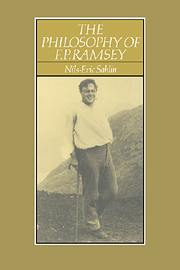Book contents
- Frontmatter
- Contents
- Preface
- Acknowledgements
- INTRODUCTION
- Chapter 1 PHILOSOPHY OF PROBABILITY
- Chapter 2 BELIEF AND TRUTH
- Chapter 3 KNOWLEDGE
- Chapter 4 GENERAL PROPOSITIONS AND CAUSALITY
- Chapter 5 PHILOSOPHY OF SCIENCE
- Chapter 6 LOGIC AND MATHEMATICS
- Chapter 7 RAMSEY'S THEOREM
- Chapter 8 UNIVERSALS
- Chapter 9 ECONOMICS
- Chapter 10 BIOGRAPHICAL GLIMPSES
- Notes
- Bibliography of F. P. Ramsey's works
- Index of names
Chapter 7 - RAMSEY'S THEOREM
Published online by Cambridge University Press: 18 September 2009
- Frontmatter
- Contents
- Preface
- Acknowledgements
- INTRODUCTION
- Chapter 1 PHILOSOPHY OF PROBABILITY
- Chapter 2 BELIEF AND TRUTH
- Chapter 3 KNOWLEDGE
- Chapter 4 GENERAL PROPOSITIONS AND CAUSALITY
- Chapter 5 PHILOSOPHY OF SCIENCE
- Chapter 6 LOGIC AND MATHEMATICS
- Chapter 7 RAMSEY'S THEOREM
- Chapter 8 UNIVERSALS
- Chapter 9 ECONOMICS
- Chapter 10 BIOGRAPHICAL GLIMPSES
- Notes
- Bibliography of F. P. Ramsey's works
- Index of names
Summary
In his essay entitled ‘Mathematical Logic’ written in 1926, Ramsey gives his opinion of the evolution of mathematical logic after the publication of Principia Mathematica. The essay is largely a defence of the ideas of logicism against the attacks by Hilbert's formalism and Brouwer's intuitionism. Ramsey had already criticized Hilbert and Brouwer in ‘The Foundation of Mathematics’, and ‘Mathematical Logic’ is only a popular version of this criticism.
The theories of the intuitionists admittedly involve giving up many of the most fruitful methods of modern analysis, for no reason, as it seems to me, except that the methods fail to conform to their prejudice.
Hilbert's view of mathematics as a game with marks is in Ramsey's eyes an impossible theory for an analysis of mathematical concepts.
Thus ‘2’ occurs not merely in ‘2 + 2 = 4’, but also in ‘It is 2 miles to the station’, which is not a meaningless formula, but a significant proposition, in which ‘2’ cannot conceivably be a meaningless mark. Nor can there be any doubt that ‘2’ is used in the same sense in the two cases, for we can use ‘2 + 2 = 4’ to infer from ‘It is two miles to the station and two miles on to the Gogs’ that ‘It is four miles to the Gogs via the station’, so that these ordinary meanings of two and four are clearly involved in ‘2 + 2 = 4’.
- Type
- Chapter
- Information
- The Philosophy of F. P. Ramsey , pp. 181 - 191Publisher: Cambridge University PressPrint publication year: 1990



